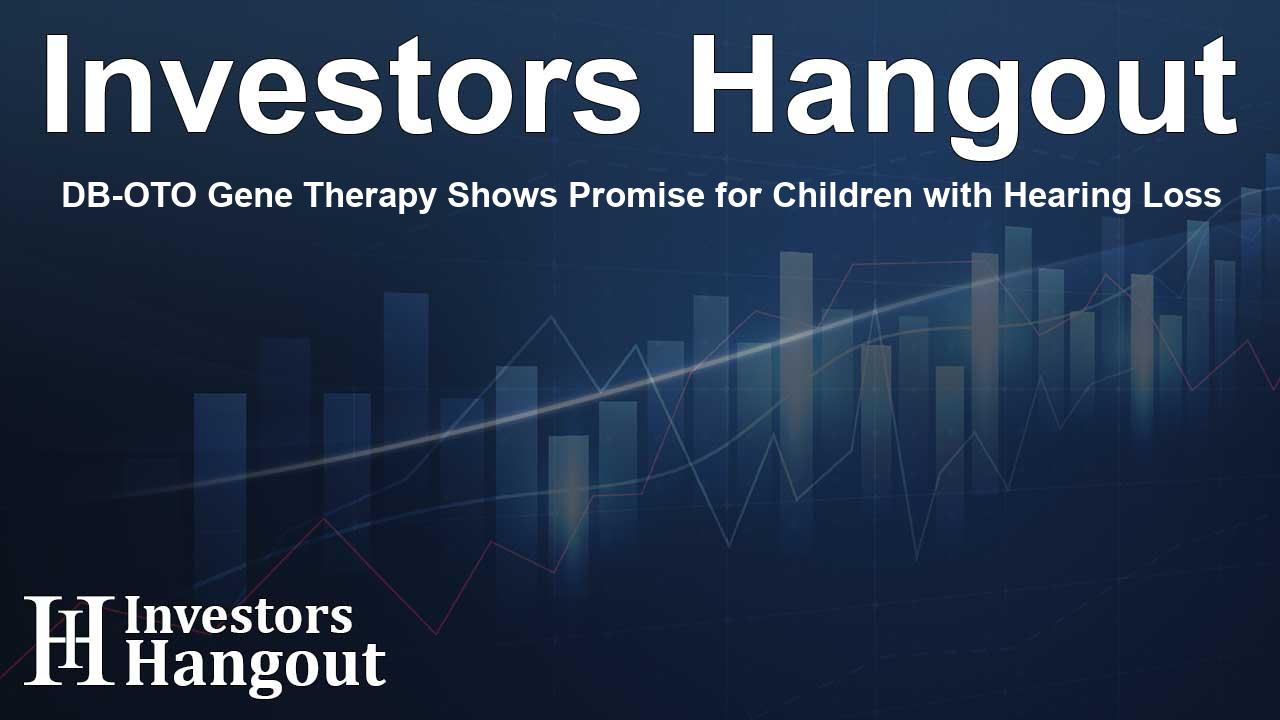DB-OTO Gene Therapy Shows Promise for Children with Hearing Loss

DB-OTO Gene Therapy: A Breakthrough in Hearing Restoration
Recent discussions at the Association for Research in Otolaryngology (ARO) highlight significant advancements in the DB-OTO gene therapy. Notably, 10 out of 11 children who underwent treatment showed remarkable improvements in their hearing abilities. This therapy, part of an ongoing study, aims to provide viable solutions for children affected by profound genetic hearing loss.
Childhood Hearing Loss: Current Challenges
Profound deafness at birth presents a critical need for innovative treatments. About 1.7 out of every 1,000 children born in the U.S. experience congenital hearing loss, with many cases stemming from genetic variants. Among these, the otoferlin (OTOF) gene variants are particularly rare, contributing to significant challenges for affected children and their families.
The CHORD Trial: Overview and Insights
The CHORD trial is an ambitious clinical study investigating the efficacy of the DB-OTO gene therapy across diverse pediatric populations. It currently includes 12 participants aged between 10 months and 16 years at enrollment. This trial aims to assess not only the safety of the surgical procedure and the gene therapy itself but also the functional outcomes post-treatment.
First Results from Participants
Among the initial participants, one child treated at just 10 months old has shown extraordinary speech and developmental gains, illustrating how early intervention can lead to significant life changes. These findings reinforce the therapy's potential as a transformational solution for genetic hearing loss.
Surgical Administration and Tolerability
DB-OTO is delivered through an intracochlear injection—a method akin to cochlear implants, tailored for very young infants. Feedback from the 12 participants indicates that both the surgical intervention and therapy are well-tolerated, with only transient vestibular events noted that resolved quickly.
Results that Inspire: What's Next for DB-OTO?
Continuing results suggested that significant improvements were observed as early as 48 weeks post-treatment, with near-normal hearing thresholds achieved in key frequency ranges. Remarkably, the positive outcomes were supported by auditory brainstem responses (ABRs) and encouraged by speech recognition tests showing comprehension of common words at conversational levels.
Monitoring Progress: Assessments and Outcomes
Aside from participant improvement, rigorous assessments through pure tone audiometry (PTA) provide a comprehensive understanding of hearing recovery. This dual assessment method validates findings, marking an essential step in establishing the therapeutic profile of DB-OTO.
The Path Ahead for Regeneron
Regeneron Pharmaceuticals, Inc. (NASDAQ: REGN) continues to explore new horizons with DB-OTO. Recognized by the U.S. FDA and the European Medicines Agency with multiple designations, this investigational therapy is gaining traction in the scientific community. Each step taken in the CHORD trial further cements Regeneron's role in reshaping treatment paradigms for genetic hearing loss.
Expanding Horizons: The Future of DB-OTO
Beyond otoferlin-related hearing loss, Regeneron is dedicated to identifying various genetic causes of hearing impairment, expanding its research to areas such as GJB2-related conditions. This commitment underscores a broader ambition to revolutionize care for those with genetic hearing loss.
Contact Regeneron for More Information
Individuals curious about the clinical trial or potential involvement can reach out directly to Regeneron's research contacts. Media inquiries can be directed to Tammy Allen at +1 914-306-2698, or via email at tammy.allen@regeneron.com. Similarly, the Investor Relations contact is Mark Hudson at +1 914-847-3482, or via email at mark.hudson@regeneron.com.
Frequently Asked Questions
What is DB-OTO gene therapy?
DB-OTO is an investigational gene therapy aimed at restoring hearing in individuals with profound genetic hearing loss due to mutations in the otoferlin gene.
How effective is the CHORD trial?
The trial has shown that 10 out of 11 participating children demonstrated significant improvements in their hearing capabilities after undergoing treatment.
What age range does the CHORD trial include?
The CHORD trial currently includes participants aged from 10 months to 16 years old.
What are the results from the DB-OTO therapy so far?
Early results indicate that some participants have achieved near-normal hearing levels within key frequency ranges after receiving the treatment.
How is DB-OTO delivered to patients?
The therapy is administered via an intracochlear injection, which is similar to the process used in cochlear implants.
About The Author
Contact Hannah Lewis privately here. Or send an email with ATTN: Hannah Lewis as the subject to contact@investorshangout.com.
About Investors Hangout
Investors Hangout is a leading online stock forum for financial discussion and learning, offering a wide range of free tools and resources. It draws in traders of all levels, who exchange market knowledge, investigate trading tactics, and keep an eye on industry developments in real time. Featuring financial articles, stock message boards, quotes, charts, company profiles, and live news updates. Through cooperative learning and a wealth of informational resources, it helps users from novices creating their first portfolios to experts honing their techniques. Join Investors Hangout today: https://investorshangout.com/
The content of this article is based on factual, publicly available information and does not represent legal, financial, or investment advice. Investors Hangout does not offer financial advice, and the author is not a licensed financial advisor. Consult a qualified advisor before making any financial or investment decisions based on this article. This article should not be considered advice to purchase, sell, or hold any securities or other investments. If any of the material provided here is inaccurate, please contact us for corrections.
